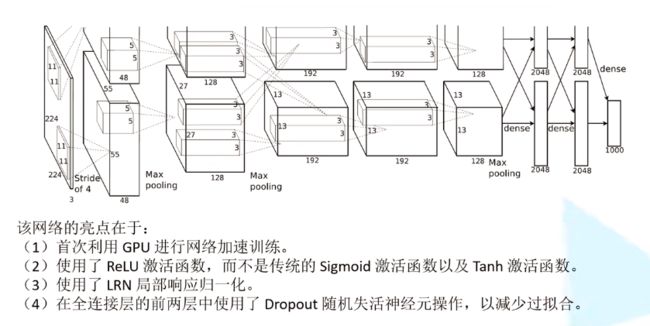AlexNet网络结构学习
一、网络详解
Dropout:
通过随机失活一部分神经元来减小网络训练参数,从而避免过拟合
各连接层参数计算
二、网络复现
1.数据集分类
在界面按住shift+鼠标右键,点powershell,输入python split_data.py运行。
2.pytorch搭建Alexnet模型
model.py:
网络设置:
self.features = nn.Sequential(
nn.Conv2d(3, 48, kernel_size=11, stride=4, padding=2), # input[3, 224, 224] output[48, 55, 55]
nn.ReLU(inplace=True),
nn.MaxPool2d(kernel_size=3, stride=2), # output[48, 27, 27]
nn.Conv2d(48, 128, kernel_size=5, padding=2), # output[128, 27, 27]
nn.ReLU(inplace=True),
nn.MaxPool2d(kernel_size=3, stride=2), # output[128, 13, 13]
nn.Conv2d(128, 192, kernel_size=3, padding=1), # output[192, 13, 13]
nn.ReLU(inplace=True),
nn.Conv2d(192, 192, kernel_size=3, padding=1), # output[192, 13, 13]
nn.ReLU(inplace=True),
nn.Conv2d(192, 128, kernel_size=3, padding=1), # output[128, 13, 13]
nn.ReLU(inplace=True),
nn.MaxPool2d(kernel_size=3, stride=2), # output[128, 6, 6]
)nn.sequential():将激活函数和网络层封装,实际在forward里才调用激活函数
padding:padding=1:在特征矩阵上下左右各补一行一列0
padding=(1,2):在特征值上下补一行0,左右补两列0
nn.ZeroPad2d[(1,2,1,2)]:在特征值上、左补一行(列)0,右、下补两列(行)0
N算出来不为整数,自动舍弃部分数据
nn.Conv2d(3, 48, kernel_size=11, stride=4, padding=2)padding=2:特征矩阵上下左右各补两行列0,N不为整数,则舍弃右下各一列行0,达到nn.ZeroPad2d[(1,2,1,2)]的效果
self.classifier = nn.Sequential(
nn.Dropout(p=0.5),
nn.Linear(128 * 6 * 6, 2048),
nn.ReLU(inplace=True),
nn.Dropout(p=0.5),
nn.Linear(2048, 2048),
nn.ReLU(inplace=True),
nn.Linear(2048, num_classes),
)nn.Dropout定义随机失活率,num_classes为分类类别,在本实验中,对五类花进行分类,num_classes=5
if init_weights:
self._initialize_weights()初始化权重
def _initialize_weights(self):
for m in self.modules():
if isinstance(m, nn.Conv2d):
nn.init.kaiming_normal_(m.weight, mode='fan_out', nonlinearity='relu')
if m.bias is not None:
nn.init.constant_(m.bias, 0)
elif isinstance(m, nn.Linear):
nn.init.normal_(m.weight, 0, 0.01)
nn.init.constant_(m.bias, 0)for循环遍历网络层,当为卷积层时,权重采用凯明初始化方法,若为全连接层,采用正态分布进行权重赋值,均值0,方差0.01。
pytorch里默认采用凯明权重初始化,可不加权重初始化部分
def forward(self, x):
x = self.features(x)
x = torch.flatten(x, start_dim=1)
x = self.classifier(x)
return xx为输入变量,经feature网络层,torch.flatten展平成一维向量,tensor类型为(batch,channel,height,weight),start_dim=1从channel开始将channel*height*weight三维展平,后输入全连接层。
train.py
data_transform = {
"train": transforms.Compose([transforms.RandomResizedCrop(224),#随机裁剪224*224
transforms.RandomHorizontalFlip(),#水平方向随机翻转 默认p=0.5,一半翻,一半不翻
transforms.ToTensor(),#转换为Tensor数据类型
transforms.Normalize((0.5, 0.5, 0.5), (0.5, 0.5, 0.5))]),#三个维度的均值、标准差
"val": transforms.Compose([transforms.Resize((224, 224)), # cannot 224, must (224, 224)
transforms.ToTensor(),
transforms.Normalize((0.5, 0.5, 0.5), (0.5, 0.5, 0.5))])}训练集和验证集不同的预处理方式
data_root = os.path.abspath(os.path.join(os.getcwd(), "../../..")) # get data root path
os.getcwd()获取当前文件目录
print(os.getcwd())
E:\pycharm\Pycharm_project\pycharm_modelos.path.join(os.getcwd(),''../..'') 返回当前路径的上上级目录
image_path = os.path.join(data_root, "data_set", "flower_data") 获取数据集路径
assert os.path.exists(image_path), "{} path does not exist.".format(image_path)假设路径存在,否则输出“...path does not exist”
train_dataset = datasets.ImageFolder(root=os.path.join(image_path, "train"),#ImageFolder加载数据集
transform=data_transform["train"])ImageFolder加载数据集
ImageFolder(root, transform=None, target_transform=None, loader=default_loader) root:在root指定的路径下寻找图片
transform:对PIL Image进行的转换操作,transform的输入是使用loader读取图片的返回对象
target_transform:对label的转换
loader:给定路径后如何读取图片,默认读取为RGB格式的PIL Image对象
原文链接:https://blog.csdn.net/weixin_39386156/article/details/102686909
DataLoader 数据加载器
dataloader = DataLoader(dataset, batch_size = 2, shuffle=True,collate_fn = mycollate)
dataset:传入数据
shuffle=True/False:是否打乱数据
flower_list = train_dataset.class_to_idx#获取分类对应的索引
#flower_list= {'daisy':0, 'dandelion':1, 'roses':2, 'sunflower':3, 'tulips':4}
# cla_dict ={0: 'daisy', 1: 'dandelion', 2: 'roses', 3: 'sunflowers', 4: 'tulips'}
cla_dict = dict((val, key) for key, val in flower_list.items())#
# write dict into json file
json_str = json.dumps(cla_dict, indent=4)#将python转换城JSON,indent=4为格式化输出,更美观
with open('class_indices.json', 'w') as json_file:
json_file.write(json_str)with open( '...', 'w' ) as f :文件存在则写内容,不存在则创建新文件
查看数据集:
def imshow(img):
img = img / 2 + 0.5 # unnormalize
npimg = img.numpy()
plt.imshow(np.transpose(npimg, (1, 2, 0)))
plt.show()
print(' '.join('%5s' % cla_dict[test_label[j].item()] for j in range(4)))
imshow(utils.make_grid(test_image))sunflowers sunflowers daisy sunflowers
# train
net.train()
...
# validate
net.eval()
...net.eval(),不启用 BatchNormalization 和 Dropout。此时pytorch会自动把BN和DropOut固定住,不会取平均,而是用训练好的值。
net.train() :启用 BatchNormalization 和 Dropout。 在模型测试阶段使用net.train() 让model变成训练模式,此时 dropout和batch normalization的操作在训练时起到防止网络过拟合的问题。
原文连接:https://blog.csdn.net/qq_46284579/article/details/120439049
训练结果:
predict.py
网上下载雏菊图片
运行结果:













